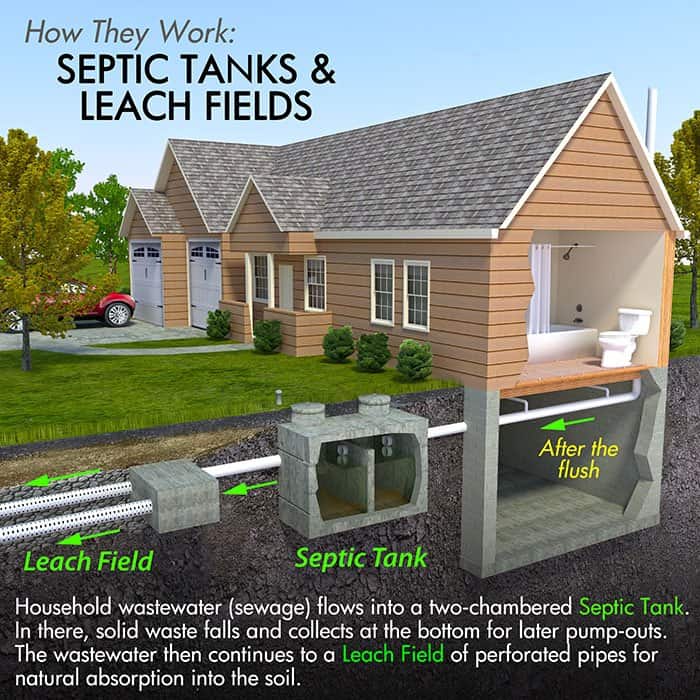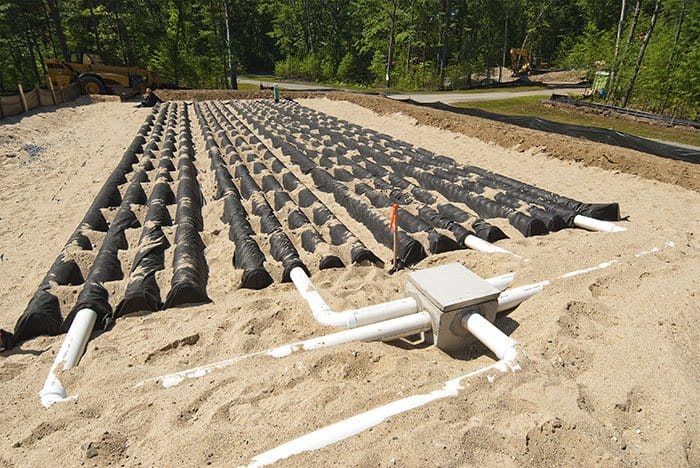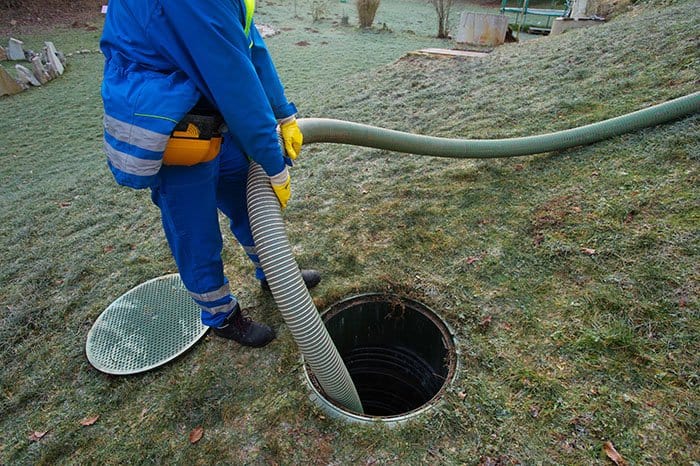If you are buying a house with a septic system, it is essential that you get that system inspected. Septic systems are just that—“systems,” and with any type of system, multiple things can potentially go wrong.
The home inspection is your opportunity to learn about the condition of your property. This is also a great time to check the septic system. If it has a problem before you close on the property, your real estate agent should be able to recommend a septic inspector. Problems can range from simple septic issues to costly repairs and very complex replacements, which can cost tens of thousands of dollars.
How The Septic System Works
A septic system at a residential property takes the place of public sewer systems. According to the EPA, Decentralized systems or Septic Systems are used in 25% of U.S. homes and are permanent components of our nation’s wastewater infrastructure.
The septic tank system begins at the sanitary pipe from the house, which transports wastewater to the septic tank. The septic tank is a large container usually made of concrete, fiberglass, or steel. It is buried and watertight, allowing the liquid in the tank to slowly break down solids and safely dispose of liquids.

This tank holds wastewater from the house, allowing solids to settle to the bottom of the tank, where it creates a “sludge” layer. Conversely, grease and oils float to the top of the tank creating a surface layer called “scum”. This scum layer creates a seal which helps keeps air out, allowing bacteria in the tank to flourish. This bacteria subsequently breaks down the solid waste in the tank.
The area in between the sludge and the scum is called effluent. This layer should consist of a mostly clear layer of liquid. There are T-shaped outlets inside the tank that allow the effluent to flow via gravity into the leach field, while Baffles keep the scum and solids from moving past the tank and into the leach field.

The effluent leaves the tank and moves into a distribution mechanism, generally called a distribution box. This box allows the effluent to flow evenly into the appropriate chambers of the leach field. Distribution methods might include distribution boxes, septic tank outlet lines, effluent distribution lines, dosing, gravity flow, pressure distribution, and siphons. No matter the method, the result is delivering effluent into the leach field.
Once in the leach field, the effluent passes into long cylindrical leaching chambers. There are a number of different options as far as the types of chambers used. The choice of appropriate chamber type depends on the percolation test results and how well the soil absorbs water.
The leaching component’s ultimate job is to allow the effluent to percolate into the subsoils, where bacteria in the upper layers of soil continue to break down materials from the tank. Further down into the ground soil, sand and rock act as a filtering system for the liquid until it eventually ends up back in the groundwater.

As you can see, there is a lot happening with a septic system. If the system is well designed, correctly installed, and maintained, it should last for a long time, but this isn’t always the case.
A lot of homeowners don’t even realize they need to provide ongoing maintenance, care, and cleaning of their septic systems. A septic system should be inspected every three to five years. The results of the inspection will determine if the tank needs to be “pumped”.
Depending on location and size the cost of inspection and pumping can run between $300 and $500. The cost of maintenance is significantly less than the cost of repair or, worse, replacement.
The Septic Inspection
If you are doing the inspection as part of your due diligence on a home purchase, you’ll want to coordinate the timing of this test to coincide with your general property inspection. Unfortunately, a general home inspector isn’t usually qualified to do a septic tank inspection. This way, if there are any problems with the home’s plumbing systems, they can be brought to the home inspector’s attention and noted in the inspection report. Additionally, batching these inspections together helps with the timing of any inspection contingency-related deadlines you are up against.
The actual inspection of the septic system starts with gathering information, this is actually more of a pre-inspection. At this stage, you’ll be rounding up documents and getting questions answered prior to the actual inspection. This process will help the inspector understand what they need to look for.
Since the system is underground, no inspection can find everything without excavating, and this is impractical. So, at this stage the process you will be trying to find clues as to where potential problems might be based on installation and maintenance.
Here is a list of questions you will want to answer before the inspection:
- Has the system ever been pumped? This one is important because it’s the only real maintenance item the seller would need to have performed.
- The location of the septic system This is important because if the seller doesn’t know where the septic is located, it’s unlikely they have provided ongoing maintenance.
- Septic Location Map– Whatever entity is in charge of overseeing septic systems in your area should have a map of the septic location provided by the original home builder. this is an important document for the septic inspection. it should show not only where the tank is located but the location of leach field as well as the number of leaching Chambers.
- Any available history on the maintenance of the system-Things like:
- How often has the system been pumped
- What contractor was used?
- Obtain any maintenance records
- Have there been any problems
- Were they repaired
- Where are the covers? The tank itself should have manhole covers over its chambers. The technician will use these to access the tank to test or clean it.
Assembling this information will do two things: first, it will help the technician inspecting the system know what to look for, and second, it will give you a sense of how the home seller maintained the system.
The On-Site Inspection
Starting at the house, the septic contractor will first try to establish that the sanitary pipe used to deliver liquid to the system is functional and intact by performing a flow test.
This test involves turning on all the water in the house to add or “charge” the system with enough water to support the number of people it was designed to support for 24 hours, which is generally a couple of hundred gallons. Hopefully, the home seller will have maintained the water pipes and system.
If little or no water flows into the tank, there is a problem with the home’s water well, plumbing, or sanitary line. Much like the sanitary line on a traditional municipal sewer system, this pipe can become displaced or cracked, allowing tree roots or other debris to clog it and cause flooding inside the house. If this is the case, the line may require a sewer line inspection.
If this type of problem exists at the inlet pipe to the tank, the technician will most likely backtrack through the home’s plumbing system, testing each individual water source until the problem is found.
On the other hand, if the tank water rises quickly, there’s most likely a problem downstream. During this test, the water entering the system should force the effluent out through the baffles and on into the leach field.
The flow test is the most substantial part of the septic test because it touches so many aspects of the system and verifies that the liquids are moving through the system in the correct manner.
A professional septic inspection may also involve a dye test. This test introduces a fluorescent dye into the septic system. The dye is typically flushed down a toilet or another drain that leads to the septic tank. After the dye has been introduced, the area around the septic tank and leach field is observed for signs of the dye. This observation period can vary, but it generally lasts for several days.
If the dye appears on the surface of the ground above the septic tank or leach field, it indicates that there are potential issues. These could be breaks or leaks in the pipes, problems with the tank itself, or failures in the leach field where the effluent is improperly surfacing instead of percolating down through the soil.
The next test should be on the tank itself and the levels of accumulated scum, effluent, sludge, and solids. While the solids are intended to remain in the tank until they are removed through septic pumping a good amount of those solids will turn into sludge and move to the bottom of the tank.
The technician will start by measuring the depth of the top scum layer. Once this is done, they begin to pump the tank until they reach the underlying sludge layer, at which point they measure that as well. These two layers should be similar in depth each accounting for about 30% of the total tank volume, the rest of the space should be dedicated to effluent. If this is not the case the technician will be looking for bigger problems later on in the leach field.

The effluent area needs to account for a larger percentage of the system because the solids in the tank need time to settle. Keeping the solids and scum out of the distribution area or leach field is important. These can cause the field to clog and fail, resulting in septic system issues and a very expensive repair.
The final area the technician will examine is the leach field. This is first done by performing a visual inspection. They look for any wet areas where water might be resting and smell for foul orders created by problems.
Finally, the technician will use a probe to test the leach field for hydraulic stress. This means the leach field is flooded. If the probe holes rapidly fill up with water, there is most likely a problem with the system.
Another point of potential failure in a septic system is at the distribution box. As the name suggests, the distribution box is responsible for distributing the effluent evenly throughout the leach field. Problems with the distribution box are usually due to settling or clogging. If this is the case, the technician will need to excavate the box in order to find out what the problem is.
As you can now see, a private residential septic system can have a wide range of potential problems. While most systems are kept in good condition and continue to work just fine for years, especially with regular septic tank pumping and regular inspection. It’s still wise for potential buyers to get a proper septic system inspection on their new home.
1995 U.S. Census data report that over 10 percent of all systems back up into homes or have wastewater emerging on the ground surface, and that more than half the systems in the United States were installed more than 30 years ago when onsite rules were nonexistent or poorly enforced.
1995 U.S. Census
As a home buyer, you want to find out about any potential problems before you close on the property. By making the septic testing a part of the inspection process, you have the ability to get the home seller involved in any additional repairs through the inspection objection contingency.
Once you’re in the home, it’s important to take care of the system so that when it’s time to sell, you will have peace of mind, knowing your septic system won’t kill the deal. This means performing a full septic tank pump on a regular basis and a routine septic inspection. Think of it as just one more home maintenance task.
